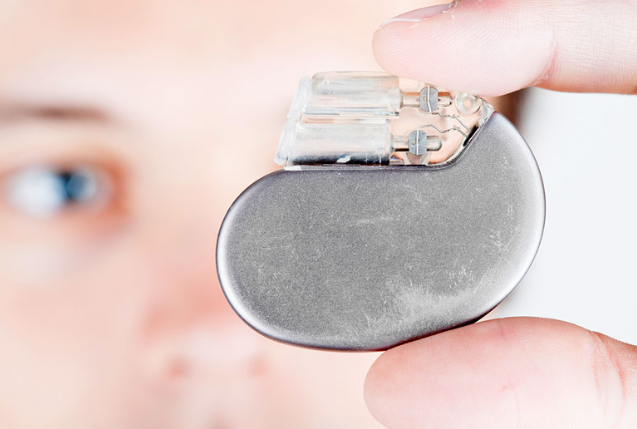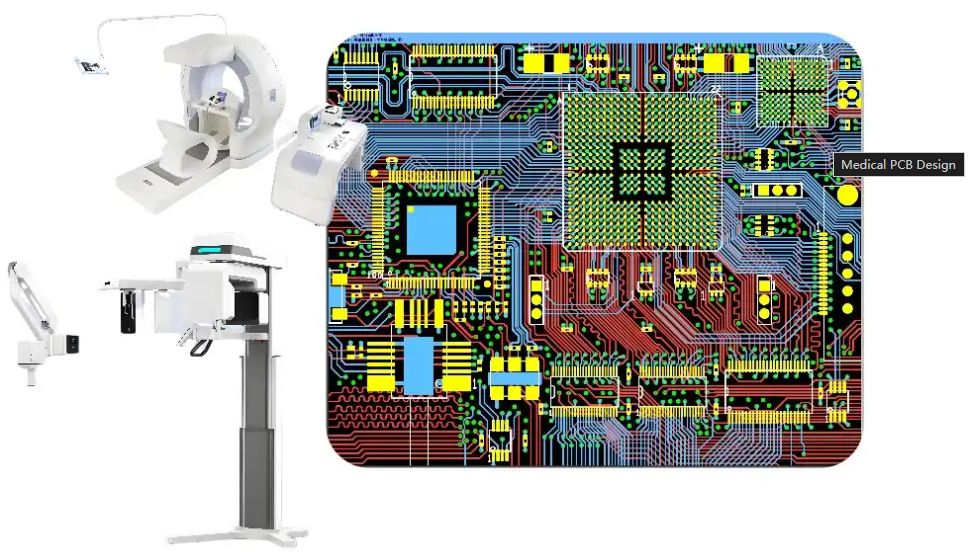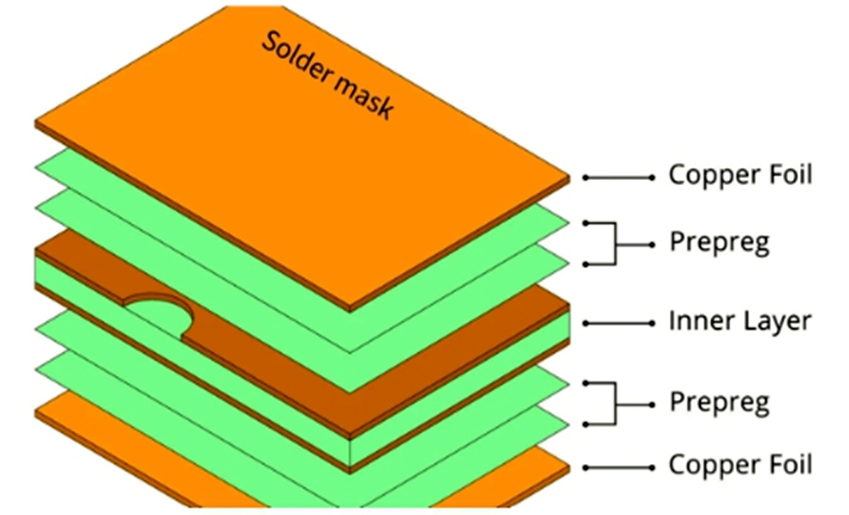Choosing the right materials for printed circuit boards (PCBs) in pacemakers is crucial for ensuring optimal performance and longevity. The materials used in pacemaker PCBs directly affect signal integrity, durability, and biocompatibility, which are vital for patient safety and device reliability in medical applications. In this blog, we’ll dive deep into how pacemaker PCB materials, biocompatible PCB designs, and medical device materials influence PCB longevity and PCB performance, providing practical insights for engineers and designers in the medical field.
Why PCB Material Selection Matters for Pacemakers
Pacemakers are life-saving medical devices that regulate heart rhythms through electrical impulses. At the core of these devices lies the PCB, which controls critical functions like signal transmission and power management. The choice of materials for these PCBs isn’t just a technical decision—it’s a matter of patient safety and device effectiveness. Poor material choices can lead to signal loss, device failure, or even harmful reactions within the body.
Materials impact several key areas, including electrical performance, mechanical stability, and biocompatibility. For instance, a PCB material with high dielectric loss can degrade signal quality, potentially causing the pacemaker to misfire or fail. Similarly, non-biocompatible materials might trigger immune responses if exposed to bodily fluids. Let’s explore how the right medical device materials can enhance both PCB performance and PCB longevity.

Key Factors in PCB Material Selection for Pacemakers
When designing PCBs for pacemakers, engineers must consider several factors to ensure the device performs reliably over many years. Below are the critical aspects of material selection that directly impact performance and durability.
1. Electrical Properties for Optimal Signal Integrity
The electrical properties of PCB materials, such as dielectric constant (Dk) and dissipation factor (Df), play a significant role in signal transmission. Pacemakers rely on precise electrical signals to stimulate the heart, and any interference or loss can be catastrophic. Materials with a low dielectric constant (typically below 3.5) and low dissipation factor (less than 0.005) help maintain signal integrity by minimizing energy loss and signal delay.
For example, high-frequency laminates like polytetrafluoroethylene (PTFE)-based materials are often used in medical PCBs due to their stable electrical performance. These materials ensure that signals travel at consistent speeds, reducing the risk of timing errors in pacemaker operation. Poor material choices, on the other hand, could result in impedance mismatches, leading to signal reflection and potential device malfunction.
2. Biocompatibility for Patient Safety
Since pacemakers are implanted in the body, the materials used in their PCBs must be biocompatible to prevent adverse reactions. Biocompatible PCB materials are those that do not cause inflammation, toxicity, or allergic responses when in contact with bodily tissues or fluids. Common biocompatible materials for pacemaker components include titanium for enclosures and certain polymers for insulation, but the PCB substrate and coatings must also meet strict standards.
Materials like polyimide are often chosen for their flexibility and biocompatibility. They can withstand the harsh environment inside the human body, including exposure to moisture and temperature fluctuations, without degrading or releasing harmful substances. Compliance with standards such as ISO 10993 (for biocompatibility testing) is essential when selecting materials for medical device materials.

3. Thermal and Mechanical Stability for Longevity
Pacemakers must operate reliably for 5 to 15 years or more inside the body, enduring constant thermal and mechanical stress. The PCB materials must resist cracking, warping, or delamination under these conditions to ensure PCB longevity. Materials with high glass transition temperatures (Tg), typically above 150°C, are preferred because they maintain structural integrity at elevated temperatures.
For instance, FR-4, a common PCB substrate, may not always be suitable for pacemakers due to its lower thermal stability. Instead, advanced materials like high-Tg epoxies or ceramic-filled laminates are used to provide better resistance to heat and mechanical stress. These materials prevent failures caused by thermal expansion or physical shocks, extending the lifespan of the device.
4. Moisture Resistance in Harsh Environments
The human body is a humid environment, and moisture ingress can corrode PCB components or cause short circuits. Materials with low moisture absorption rates (less than 0.2%) are critical for maintaining PCB performance over time. Hydrophobic coatings and substrates like PTFE help repel water, protecting the delicate circuits inside the pacemaker.
Without proper moisture resistance, a PCB could experience electrical leakage or corrosion of copper traces, leading to device failure. Engineers often apply conformal coatings or hermetic sealing to further shield the PCB, but the base material’s inherent resistance to moisture remains a foundational factor.
Common Materials Used in Pacemaker PCBs
Selecting the right materials involves balancing electrical, thermal, mechanical, and biocompatibility requirements. Below are some commonly used materials for pacemaker PCB materials and their benefits.
- Polyimide: Known for its flexibility and high thermal stability, polyimide is ideal for flexible PCBs in pacemakers. It also offers excellent biocompatibility, making it safe for implantation.
- PTFE-Based Laminates: These materials provide low dielectric loss and high-frequency performance, ensuring reliable signal transmission in critical medical devices.
- High-Tg Epoxies: Offering enhanced thermal and mechanical stability, these epoxies are suitable for rigid PCBs that need to withstand long-term stress.
- Ceramic Substrates: Used in high-reliability applications, ceramics provide superior thermal conductivity and electrical insulation, though they are less flexible and more expensive.
Each material has trade-offs. For example, while ceramic substrates excel in thermal management, their rigidity may not suit designs requiring flexibility. Engineers must carefully match materials to the specific needs of the pacemaker design to optimize both performance and durability.

How Material Selection Impacts Pacemaker Performance
The performance of a pacemaker is directly tied to how well its PCB handles electrical signals, power efficiency, and environmental challenges. Here’s how material selection influences key performance metrics:
Signal Accuracy and Speed
As mentioned earlier, materials with low dielectric constants and dissipation factors ensure minimal signal loss and delay. For pacemakers, even a microsecond delay in signal delivery can disrupt heart rhythm regulation. High-performance materials maintain impedance values within tight tolerances (e.g., ±10% of the target 50 ohms), ensuring accurate and timely signal delivery.
Power Efficiency and Battery Life
Pacemakers rely on small batteries that must last for years. PCB materials with low energy loss help reduce power consumption by minimizing leakage currents. For instance, using a substrate with a low dissipation factor can improve power efficiency by up to 5-10%, extending battery life and reducing the need for surgical replacements.
Reliability Under Stress
Materials that resist thermal cycling and mechanical stress prevent failures like trace cracking or solder joint fatigue. A study on implantable devices found that PCBs made with high-Tg materials had a 30% lower failure rate over 10 years compared to standard FR-4 boards, highlighting the importance of material durability for PCB longevity.
Regulatory Standards for Medical PCB Materials
Designing PCBs for pacemakers involves strict adherence to regulatory standards to ensure safety and reliability. Key standards include:
- ISO 13485: A quality management system standard for medical device manufacturing, ensuring consistent design and production processes.
- IPC Class 3: The highest reliability standard for electronics, requiring PCBs to meet stringent criteria for performance in life-supporting applications.
- FDA Guidelines: In the United States, the Food and Drug Administration mandates rigorous testing of materials for biocompatibility and long-term safety.
Compliance with these standards often requires extensive testing of medical device materials, including accelerated aging tests to simulate years of use in months. Materials must pass these tests to prove they can maintain PCB performance and safety over the device’s intended lifespan.
Challenges in Selecting PCB Materials for Pacemakers
Despite advancements in material science, engineers face several challenges when selecting materials for pacemaker PCBs:
- Cost vs. Performance: High-performance materials like ceramics or PTFE laminates are expensive, increasing production costs. Balancing cost with reliability is a constant challenge.
- Miniaturization: As pacemakers become smaller, PCBs must fit into tighter spaces without sacrificing performance. Flexible materials like polyimide are often needed, but they may not offer the same electrical properties as rigid substrates.
- Long-Term Testing: Predicting how materials will behave over 10-15 years in the body is difficult, even with accelerated testing. Unexpected degradation can still occur.
Addressing these challenges requires collaboration between material scientists, engineers, and medical professionals to develop innovative solutions that prioritize patient safety and device reliability.
Future Trends in Pacemaker PCB Materials
The field of medical electronics is evolving rapidly, and new materials are being developed to improve pacemaker performance. Some emerging trends include:
- Bioabsorbable Materials: Research is underway to create PCBs with materials that safely dissolve in the body after the device’s useful life, reducing the need for surgical removal.
- Nanomaterials: Nanoscale coatings and substrates could enhance electrical performance and biocompatibility while reducing the size of PCBs.
- Self-Healing Polymers: These materials could repair minor cracks or damage over time, significantly extending PCB longevity.
While these innovations are still in the research phase, they hold promise for creating pacemakers that are smaller, safer, and longer-lasting.
Conclusion: Making Informed Choices for Pacemaker PCBs
The selection of pacemaker PCB materials is a critical decision that impacts both PCB performance and PCB longevity. By prioritizing electrical properties, biocompatibility, thermal stability, and moisture resistance, engineers can design pacemakers that operate reliably for years while ensuring patient safety. Understanding the benefits and limitations of materials like polyimide, PTFE laminates, and high-Tg epoxies allows for informed choices that balance cost, performance, and regulatory compliance.
As technology advances, new medical device materials and design techniques will continue to push the boundaries of what’s possible in pacemaker development. For now, focusing on proven materials and rigorous testing remains the best way to create biocompatible PCB designs that save lives. Whether you’re an engineer or a designer, staying updated on material advancements and industry standards is key to success in this critical field.
 ALLPCB
ALLPCB







